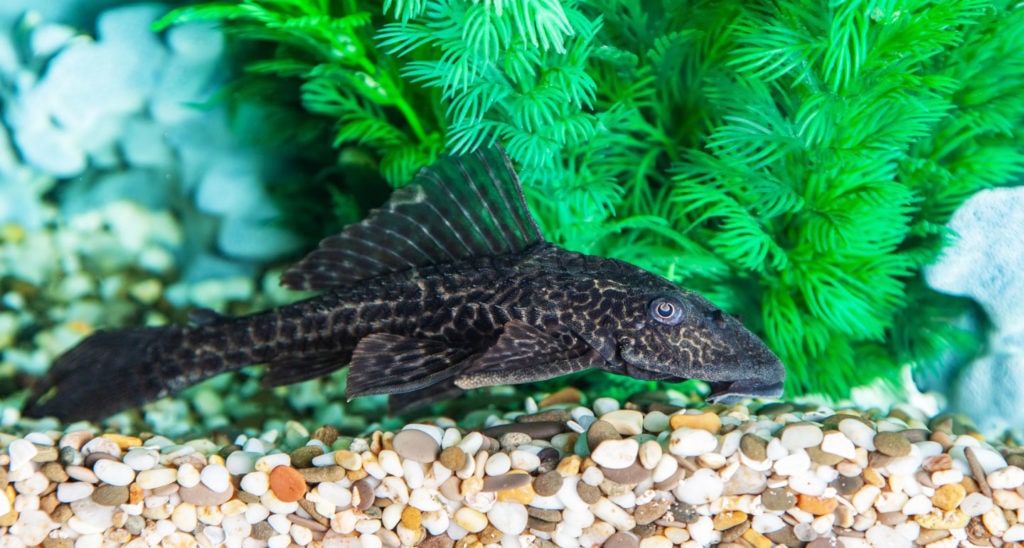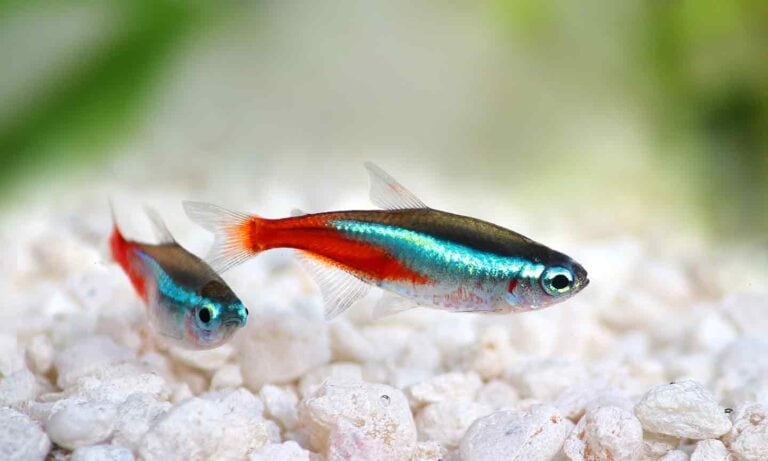Two months ago, you bought that little 10 gallon fish aquarium and stocked it with the usual nice, friendly community fish. Everything has been going really well. You worked through the cycle, you lost one or two, but that was to be expected. After the tank cycled, you added some new fish, and they’re doing great. But. . . what’s that? There’s an ugly brownish spot on the front. The tank is rusting!
Quickly, you call your fish friend and ask what’s going on with the tank. “It’s just allergies? What do you mean my tank has allergies?! Oh, algae! Okay, so I need an algae eater!”
A visit to the fish store reveals an entire world of algae eaters. The salesperson steers you, oddly enough, away from the fish labeled “algae eaters,” explaining that they get kind of big, don’t eat algae when they get big, and can kill your fish. Instead, he recommends this sucker called a Plecostomus. You plop down your $5, and you and Mr. Pleco are on your way home.
Mr. Pleco does a great job of eating the algae in the tank, too. But two weeks later, he’s dead. If you’ve got a good store, they explain to you that you do actually need to feed your pleco, sell you another and a bag of algae wafers. If you’ve got a bad store, they just sell you another. So, you and Mr. Pleco (the Second) head home, and you feed him. And he lives. And he grows. And grows. And grows. And grows. And grows.
What Is a Pleco?
The fish in question is called the common pleco, and is known scientifically as Hypostomus plecostomus. About a half dozen other fishes are also commonly sold as the pleco. They all look basically the same, and can be pretty hard to tell apart. They’re members of a family of catfishes known as the Loricariidae, which has somewhere around 700 described species and something like a billion undescribed species. While the common plecos are kind of ugly, some are breathtakingly beautiful (and some are really ugly).
As many, many aquarists have discovered, one of the big problems with the common plecos is that they get big. Really big. These guys tend to max out, in the average home aquarium, at between 12 and 24 inches, and some can get bigger. This puts the fish at a size that is far too large for average home aquariums. As these are very active fish, coming from fast flowing, heavily oxygenated waters, their life in a small aquarium with decreasing capacity (as a single large fish becomes an increasing burden on the tank) is undoubtedly torturous. Many aquarists argue that they just “lay there” anyhow, but I doubt very much so that those aquarists are ever looking at their tank under dim light at 3 a.m. Plecos, like a lot of catfish, are nocturnal.
So, what’s an aquarist to do with an overgrown catfish who can wipe both sides of the glass clear with a swipe of his tail? Take it back to the fish store, you say? You’ll be lucky if they’ll take it. Unfortunately, you and 10 other people have been in today with an overgrown pleco, and — surprise, surprise — there’s no market for them.
The Dangers of Plecos in the Wild
Unfortunately, a large number of aquarists have turned to the next obvious solution, returning Nemo to the ocean, or in this case, Mr. Pleco (XVI) to the local river. Before explaining why, I’m going to just come out and say: Don’t do this. Most of the time, the pleco is simply doomed to freeze to death once colder weather comes, but even in the meanwhile, they can cause a world of damage.
First and foremost, most plecos are not natural algae eaters. They’re instead omnivores, and they eat what is termed aufwuch. This is a mixture of algae growing on surfaces (periphyton), insect larvae, and other aquatic organisms. It is unquestionably the most important food source produced in most water bodies, and vital to the overall community. Larger aquatic insects, amphibian larvae, snails, crayfish, and native fish eat this. Your Mr. Pleco (XIX), in just a few months, can eat a tremendous amount of this. He’s armoured and no native predators stand a chance against him. In short, he’s an eating machine crossed with a tank. Numerous native algae-eating minnows and other animals are endangered, and competition with a pleco is not going to help them.
Secondly, whenever we release any aquarium fish into the wild, there’s a very real risk of introducing non-native diseases which can wipe out native populations.
Third, plecos are unusual fish in that they live in burrows. A pleco will construct a cave in the mud wall and live and spawn there. Unfortunately, plecos are doing just that in many areas of the United States. The common pleco is established throughout the American South, and can be found from California to Florida. They’ve been collected, during warm months, in virtually every state, and have been found in warm-water areas around power plants, treatment plants and the like. Their burrowing behavior seriously undermines embankments, and has been cited in injuries. Further, all this digging – or, especially, when a bank collapses – causes a huge influx of dirt. All this dirt increases turbidity and can seriously jeopardize spawning sites of any native fishes relying on a clean bottom.
Plecos belong to a group of invasive aquarium fish that I group together as “TBTBS:” Too Big To Be Sold. A lot of our invasive fish are fish who outgrow the average home aquarium. Stuck with the alternative of euthanasia, too many aquarists release the fish into the wild, either dooming it to a slow death come winter, or “euthanizing” our native waters.
Solving the Pleco Problem
Remember I said there were exactly 700 known species of Loricaridae? With that many choices, there are plenty that are inexpensive, stay small, and are great algae eaters (some even better than the “pleco”).
The most important of these are the various bushy or bristle nose plecos now becoming widely available. They’re fantastic algae eaters. Depending on species, they’ll max out at less than 6″, with the most common species reaching about 3-4″. Oh, and they’re really easy to breed. My local fish club has fry available at every auction. If you can’t get them at the local fish store, try your aquarium club. Best of all, they are the only pleco I know of that likes that brown, slimy diatom algae that shows up in all of my tanks. At the aquarium store, expect to pay less than $10 each.
The Clown Peckoltia is a beautiful small pleco. They’ll get to about 3 inches. Only one word of warning: Peckoltia don’t like one another, so keep only one in the tank. Expect to pay $8 or so each.
Want a really small algae eater for your small tank? Try a small group of Otocinclus (or “Otto”) cats. They get to about 2 inches, max. They do best in a small group, and they’re active during the day. They’re the perfect algae eater for a small tank. You’ll probably pay about $3-4 each for them, but you do want a small group.
Want something unusual? Check out the Farlowella. Most of the Farlowella in the aquarium trade get to about 6-8 inches, which is not too big for most tanks. They look kind of like twigs, and are a really neat, unusual addition. Best of all, they like to breed in the aquarium and, for whatever reason, their favorite place to lay eggs is usually on the front or side of the glass. Expect to pay a little bit more, about $15-20 each.
Of course, there are lots of other algae eating fish who don’t get too big and aren’t catfishes, including various flying foxes, many barbs, and many other fishes. And there are still 650 species of Loricaridae I haven’t mentioned. Chances are, there’s an algae eater for your tank that will not outgrow it. When choosing one, pick one that reaches an acceptable maximum size. Aquarists long ago decided that the traditional “Chinese Algae Eater” was an unacceptable aquarium fish – for reasons mentioned above. As a result, it’s almost gone from the hobby. Let’s see the Giant Plecos go that way, too!
Remember, though, that the job of keeping the glass and ornaments clean falls on you, not the fish. The best “algae eater” for the home aquarium is the one I like to see released to the wild regularly: the aquarist. An algae brush is the only thing that is going to keep the aquarium clean and free of algae (short of not putting water in it). If you add an algae eating fish, do so because you like the fish, not because you expect him to keep your tank clean.
Posted by: Chewy Editorial
Share:









